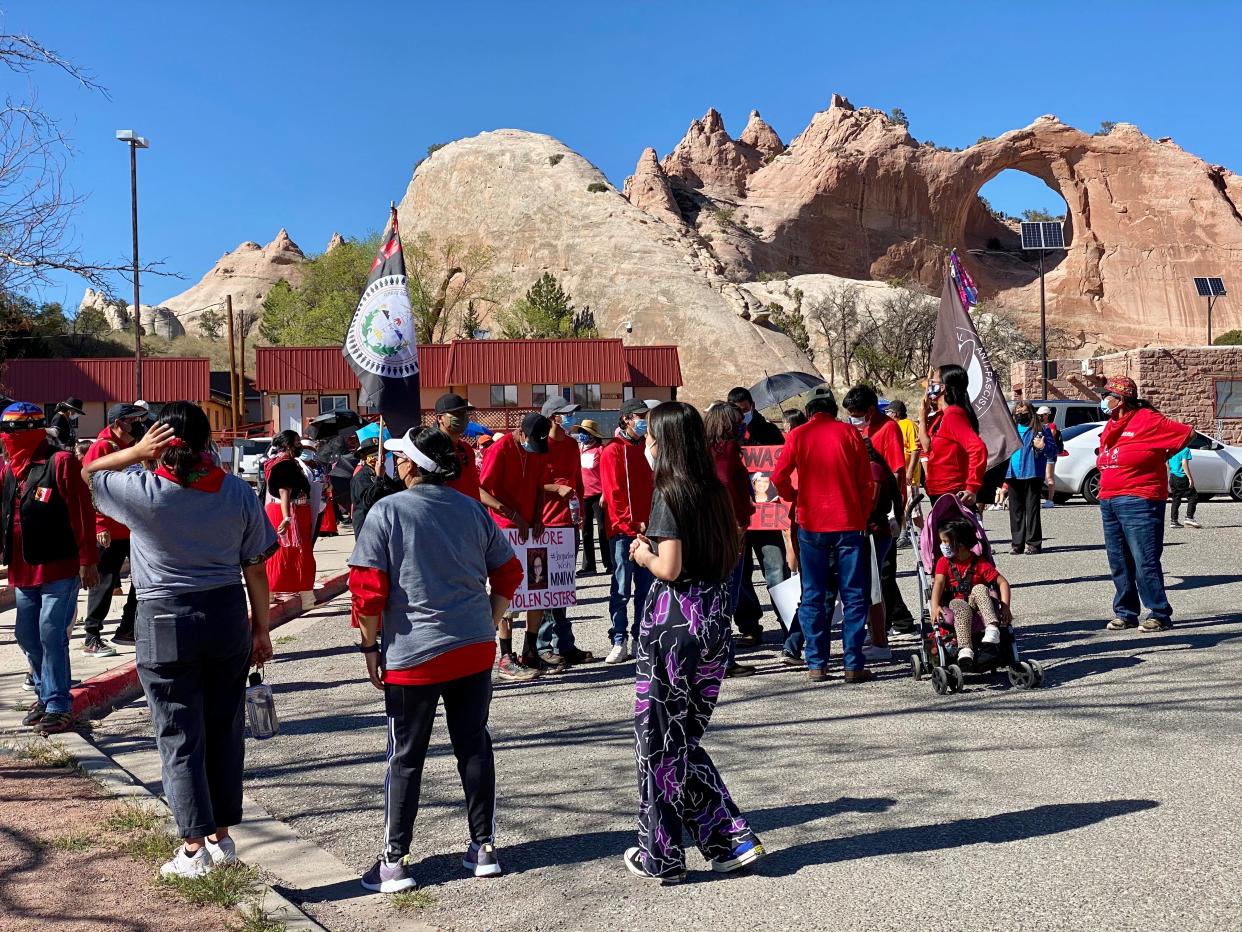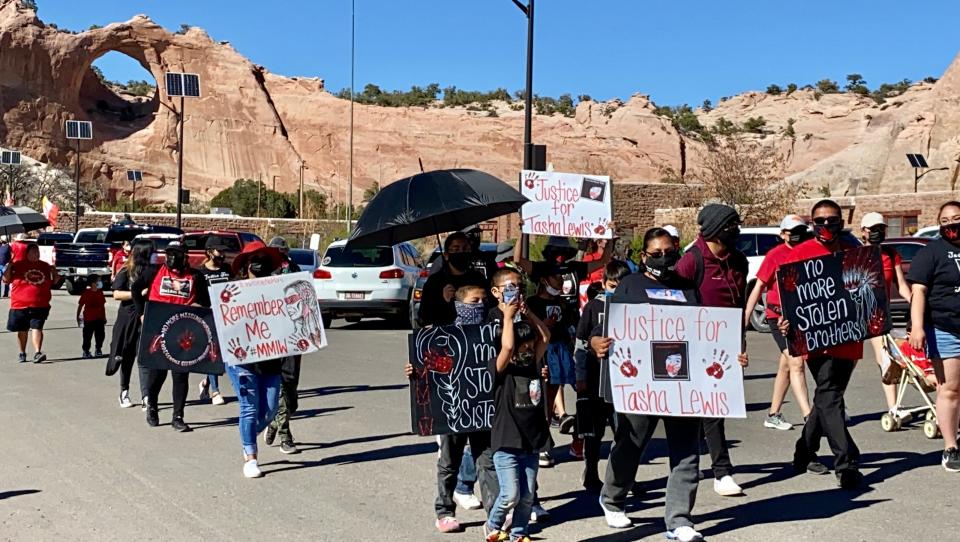FBI releases names of 170 missing Indigenous people in New Mexico and on the Navajo Nation

The FBI in New Mexico released the names of 170 missing Indigenous people in an attempt to locate them and to encourage families to report their missing loved ones.
The list, along with some photos, includes members of the Navajo Nation and New Mexico Pueblo tribes. The oldest case is that of Walcie Downing, who has been missing since Dec. 14, 1956. There was no picture with her name, although an online search turns up a black-and-white picture of her, smiling.
The details of her disappearance, along with the other 169 missing people, are not part of the FBI list. Compiling the names, birthdates and dates of disappearance took the agency six months of combining and validating different databases of missing Indigenous persons in New Mexico.
The agency confirmed the status of missing Indigenous persons as listed in the National Crime Information Center. Many records of missing Indigenous persons were incomplete or outdated because the record was not updated once additional details were made available or once the person was located, according to the FBI.
“The FBI resources and manpower dedicated to producing this validated list of missing Indigenous persons across New Mexico is critical to define the true scope of MMIWR in the state,” said Lynn Trujillo, New Mexico Indian Affairs Department secretary and chairperson of the MMIWR Task Force. MMIWR stands for Missing and Murdered Indigenous Women and Relatives.

“The data shared today will guide the state’s response to this ongoing crisis," Trujillo said. "The task force will continue strengthening partnerships across all levels of government, including grassroots organizations that are on the ground providing direct support to families and communities.”
The list is further evidence of the number of missing Indigenous people across the country. A 2016 report from the National Crime Information Center said there were 5,712 reports of missing American Indian and Alaska Native women and girls. The U.S. Department of Justice federal missing persons database, NamUs, logged 116 cases, according to Urban Indian Health Institute, which is the source most cited in reporting these crucial numbers.
In Arizona, 160 Indigenous women and girls were known to be missing from 1976 to 2018. Some 57% of Indigenous women and girls are killed in urban areas around Phoenix, Mesa and Scottsdale, followed by 23% in rural areas of the state, and 20% in other locations, according to a 2020 Arizona statewide study.
Advocates continue to speak up, especially family members of those who have gone missing. Seraphine Warren is currently on a journey walking across the country to Washington D.C. to raise awareness for her aunt Ella Mae Begay, who went missing June 15, 2021.
“What people don't understand is there isn't much hope or resources to turn to,” said Warren in an earlier interview. “When someone goes missing, you put all your hopes and confidence in the police department to find out something, and it hasn’t happened yet. It’s been like that for years on the Navajo Nation.”
List doesn't cover Arizona yet
Frank Fisher, FBI’s public affairs specialist in New Mexico, said the Navajo Nation helped in the effort to compile the list of missing people in the state.
"We had input from other Native American reservations and pueblos in New Mexico, not just the Navajo Nation," he said.
Whether this list will be replicated in Arizona is not clear. Fisher, along with Kevin Smith, the Arizona FBI public information officer, both told The Arizona Republic that the list is a project New Mexico will start.
In time, the Arizona FBI office will assess whether it’s ready to replicate the list in other places, taking into account the nuances and differences within each state with Indian Country responsibility.
“I can tell you that the Navajo Nation data they are using includes Arizona, which is good,” said Smith.
He also explained how the Arizona FBI office works to address missing Indigenous people cases. The agency conducts enhanced and specialized training for agents assigned to Indian Country and agents and tribal police work together on the cases, Smith said.
The FBI maintains satellite offices (called “resident agencies”) throughout Arizona with agents on the ground working with tribal partners to investigate violent crime. These agents and professional staff are located in Flagstaff, Gallup, Tucson, Lake Havasu City and Sierra Vista.
Nez: Working to 'help heal our people'
Navajo Nation President Jonathan Nez said tribal leaders appreciate the FBI’s support, but communication and coordination can and should be improved when it comes to working with families in tribal communities.
“In many situations, missing persons cases are turned over to the FBI, and the Navajo Nation’s Department of Criminal Investigations does not have complete information to share with families,” Nez told The Republic.
Awareness campaign: Families and advocates seek justice for missing and murdered Indigenous people
He noted that in May, the Navajo Nation published a poster that identified over 50 missing persons dating back several decades.
“With the publication of missing persons through the BIA, FBI, Navajo Nation, and grassroots efforts, we are hopeful that we can bring more of our people home and help to heal our people,” he said.
The FBI vetted hundreds of files and arrived at more than 170 cases of Native Americans in New Mexico who have been verified as missing. The list includes all missing Indigenous persons within New Mexico, but it also includes the Navajo Nation, which crosses into Arizona and Utah. The FBI plans to update the names monthly, officials said.
A long-standing issue
Phillip Francisco, the former chief of Navajo Nation police and currently police chief at Bloomfield Police Department in Bloomfield, New Mexico, said he had noticed early on that the missing people on Navajo are often men.
“From what I was seeing, there were a lot of men missing,” said Francisco. “There are 116 of those on the list of 170 which are males. There hasn’t been the same push to find our missing male relatives, which is disheartening.”
He said the tribal affiliation, and whether or not the missing are from urban areas or from tribal lands, are not listed on the FBI list. But he did say while chief at NNPD, about 60 people who were missing were identified.
"I’ve had a long-standing stance that the underlying issue is drugs and alcohol, the main culprit causing our people to go missing," he said.
“These numbers go back to the 50s so this is a long-standing issue,” said Francisco. “I think the Navajo Nation should concentrate on getting our own people out of the cycle of substance abuse. I really hope they look deeper at these problems. I know there is a big push for leadership to clean up the mess that’s been made but how do you stop the mess from happening in the first place?”
If an Indigenous family member who is missing is not included in this list, the relatives are urged to contact their local or tribal law enforcement agency and ask them to submit a missing person report to NCIC.
For further assistance with their request, family members or local law enforcement can contact the New Mexico Attorney General’s Office or the FBI. This project is in addition to the FBI’s continuing efforts to call attention to unsolved Indigenous homicides and missing person cases it is investigating.
Arlyssa D. Becenti covers Indigenous affairs for The Arizona Republic and azcentral. Send ideas and tips to arlyssa.becenti@arizonarepublic.com. Follow her on Twitter @ABecenti
Support local journalism. Subscribe to azcentral.com today.
This article originally appeared on Arizona Republic: FBI releases list of 170 missing Indigenous people in New Mexico

